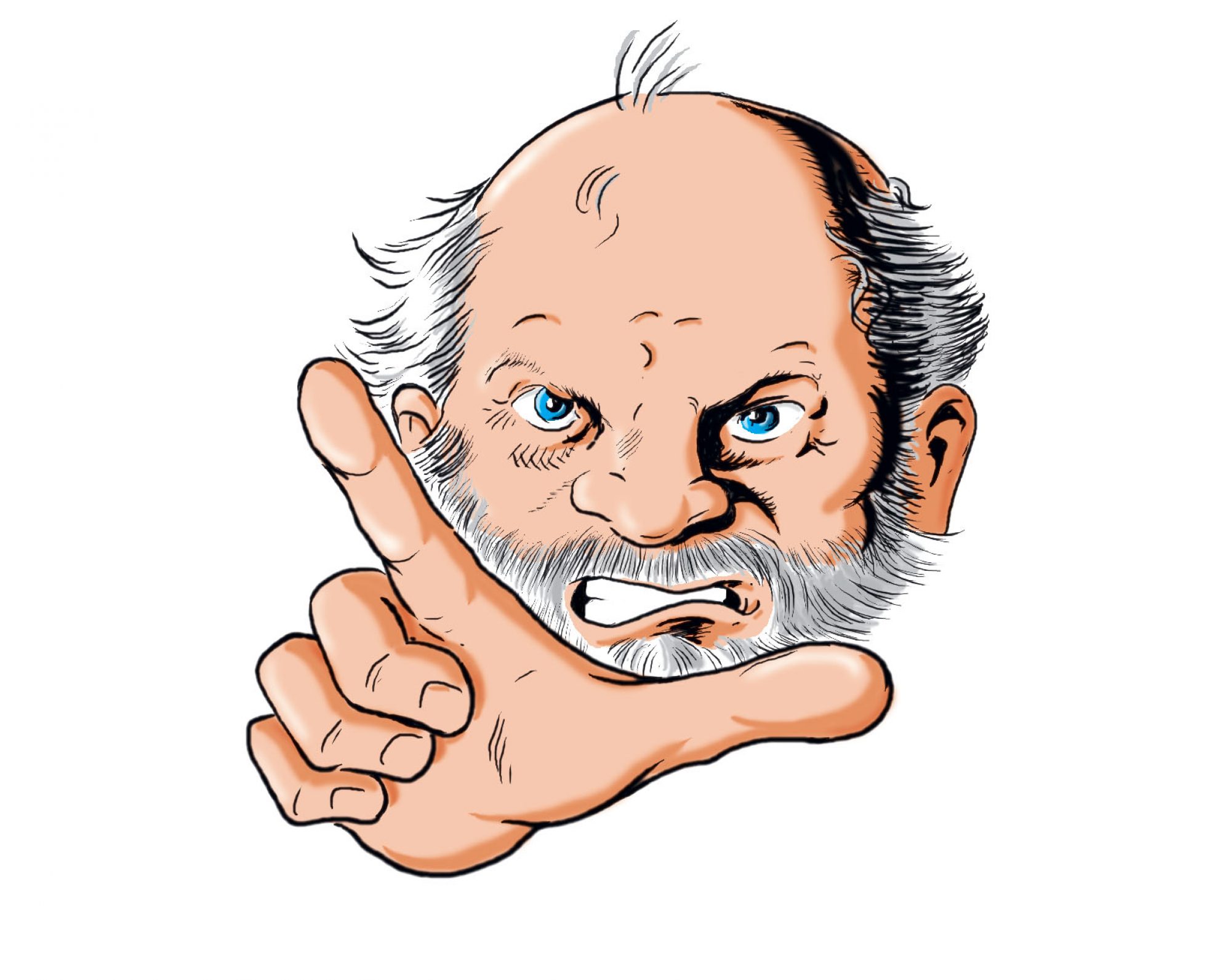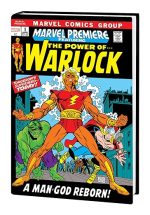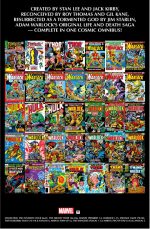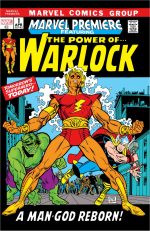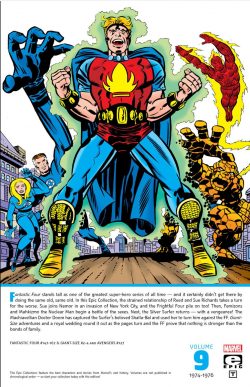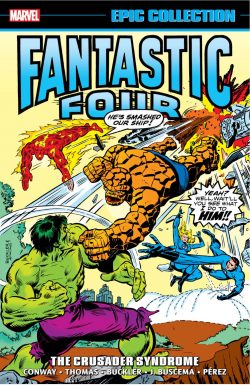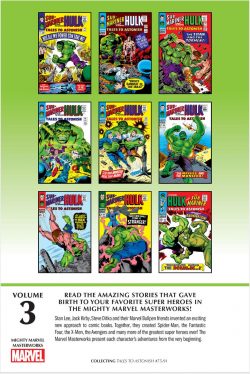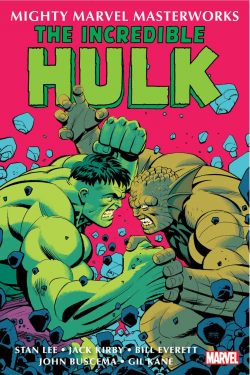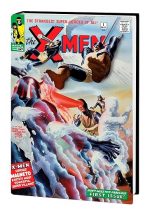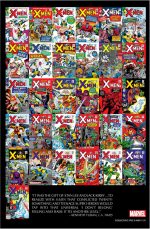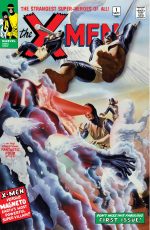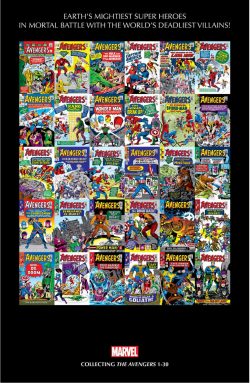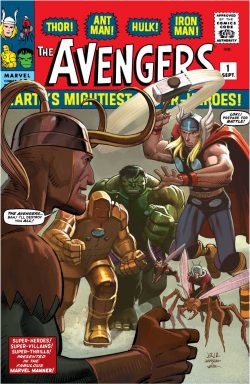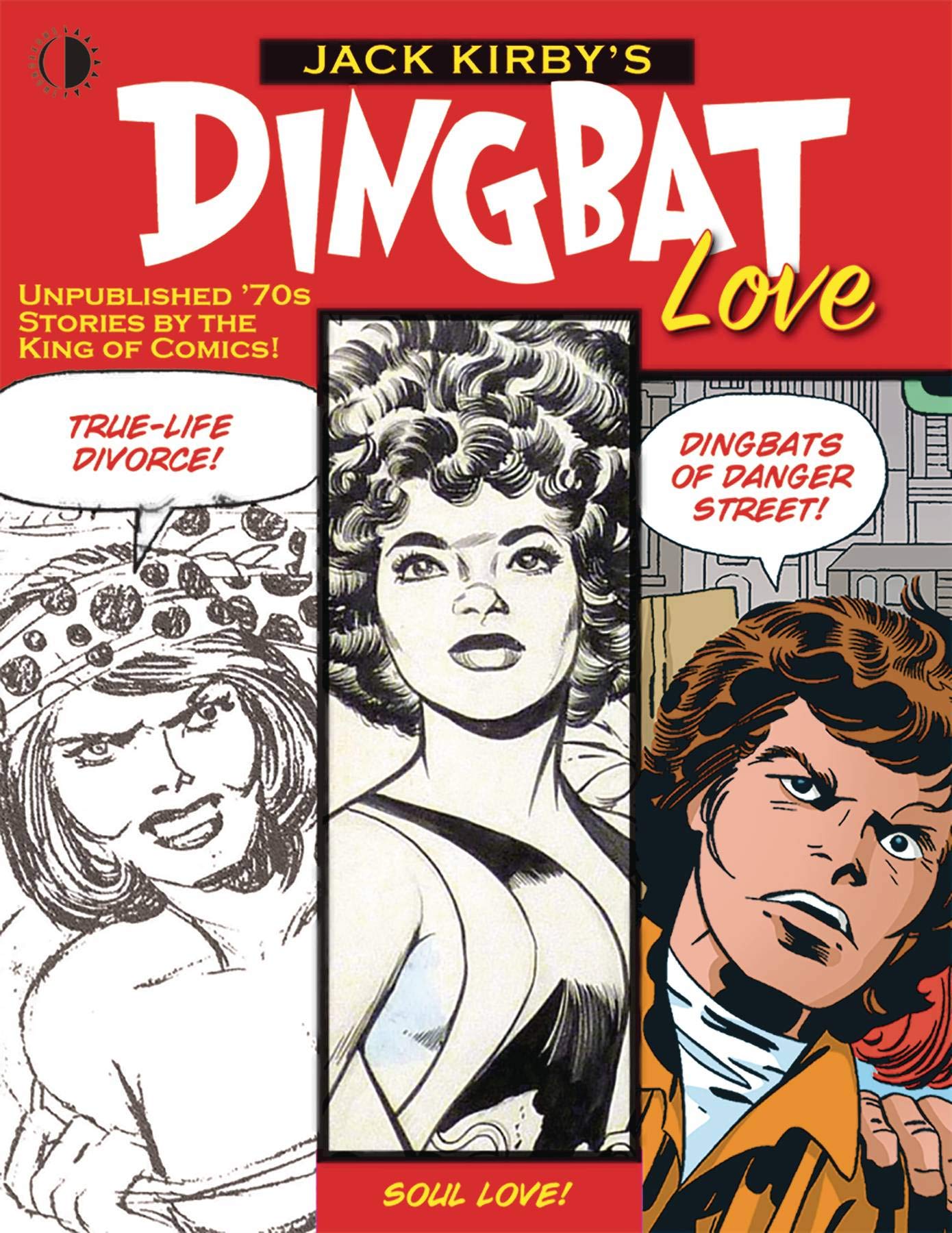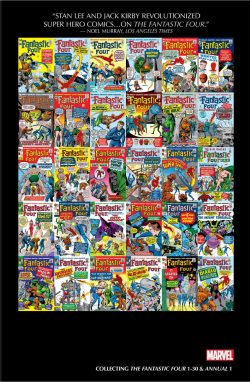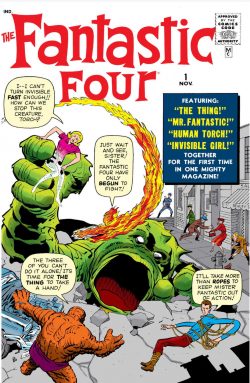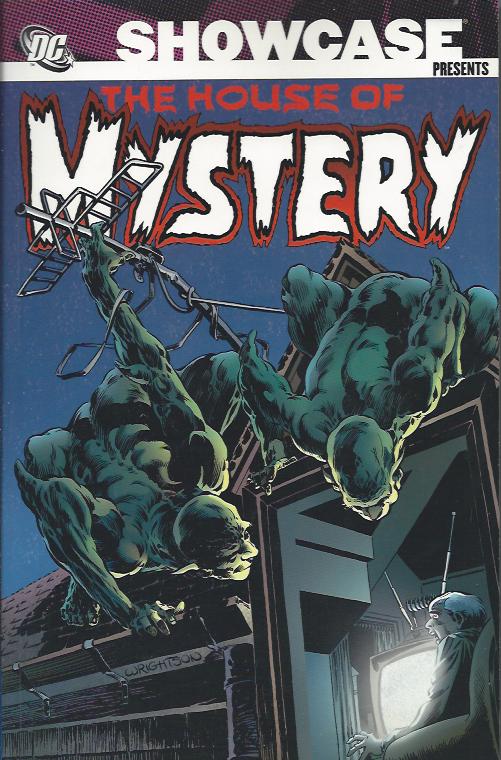

By Jack Kirby, D. Bruce Berry & Mike Royer with Gerry Conway, Steve Sherman, Paul Levitz & various (DC Comics)
ISBN: 978-1-7795-2171 (TPB/Digital edition)
With elections looming, it’s hard not to worry about the world that’s coming, and as usual I’m retreating into comics for emotional sustenance. Sadly the prevailing attitude is one of doom and gloom whoever wins, so – in anticipation of calamity unbounded – here’s a comforting look at another always-rewarding end of world scenario…
Other than Gotham City, Jack Kirby’s Earth AD (After Disaster) is DC’s most successful and inspirational Dystopia. It has migrated to television via numerous animated features and informs many aspects of the greater shared continuity. In so many ways it’s a far more enticing world than the one we currently inhabit… albeit not for much longer…
Jack Kirby (28th August 1917 – 6th February 1994) was – and nearly 30 years after his death, remains – the most important single influence in the history of American comics. There are innumerable accounts of and testaments to what the man has done and meant, and you should read those if you are at all interested in our medium. Kirby was a man of vast imagination who translated big concepts into astoundingly potent and accessible symbols for generations of fantasy fans. If you were exposed to Kirby as an impressionable child you were his for life. To be honest, that probably applies whatever age you jump aboard the “Kirby Express”…
Synonymous with larger than life characters and vast cosmic imaginings, “ The King” was an astute, spiritual man who had lived through poverty, prejudice, gangsterism, the Depression and World War II. He experienced Pre-War privation, Post-War optimism, Cold War paranoia, political cynicism and the birth and death of peace-seeking counter-cultures, but always looked to the future while understanding human nature intimately. Beginning in the late 1930s, it took a remarkably short time for Kirby and his creative collaborator Joe Simon to become the wonder-kid dream-team of the new-born comic book industry. Together they produced a year’s worth of influential monthly mag Blue Bolt, dashed off Captain Marvel Adventures (#1) for overstretched Fawcett, and – after Martin Goodman appointed Simon editor at Timely Comics – launched a host of iconic characters including Red Raven, Marvel Boy, Mercury/Hurricane, The Vision, Young Allies and million-selling mega-hit Captain America. When Goodman failed to make good on his financial obligations, Simon & Kirby were snapped up by National/DC, who welcomed them with open arms and a fat chequebook.
Bursting with ideas the staid industry leaders were never really comfortable with, the pair were initially an uneasy fit, and awarded two moribund strips to play with until they found their creative feet: Sandman and Manhunter. They turned both around virtually overnight and, once safely established and left to their own devices, switched to the “Kid Gang” genre they had pioneered at Timely. Joe & Jack created wartime sales sensation Boy Commandos and Homefront iteration The Newsboy Legion before being called up to serve in the war they had been fighting on comic pages since 1940.
Once demobbed, they returned to a very different funnybook business, and soon after left National to create their own little empire…
Simon & Kirby ushered in the first American age of mature comics – not just by inventing the Romance genre, but with all manner of challenging modern material about real people in extraordinary situations before seeing it all disappear again in less than eight years.
After years of working for others, Simon & Kirby established their own publishing house: making comics for a far more sophisticated audience, only to find themselves in a sales downturn and awash in public hysteria generated by an anti-comicbook pogrom. Their small stable of magazines – generated for an association of companies known as Prize, Crestwood, Pines, Essenkay and Mainline Comics – blossomed and as quickly wilted when the industry contracted throughout the 1950s, but had left future generations fascinating ventures such as Boys’ Ranch, Bullseye, Crime Does Not Pay, Black Magic, Boy Explorers, Fighting American and the entire genre of Romance Comics…
Hysterical censorship-fever spearheaded by US Senator Estes Kefauver and opportunistic pop psychologist Dr. Frederic Wertham led to witch-hunting Senate hearings. Caving in, most publishers adopted a castrating straitjacket of draconian self-regulatory rules. Crime and Horror titles produced under the aegis and emblem of the Comics Code Authority were sanitised and anodyne affairs in terms of mature themes, political commentary, shock and gore even though the market’s appetite for suspense and the uncanny was still high. Crime comics vanished as adult sensibilities challenging an increasingly stratified and oppressive society were suppressed. Suspense and horror were dialled back to the level of technological fairy tales and whimsical parables…
Simon left the business for advertising, but Jack soldiered on, taking his skills and ideas to safer, more conventional, less experimental companies. As the panic abated, Kirby returned briefly to DC Comics, working on bread-&-butter anthological mystery tales and revamping Green Arrow (at that time a back-up feature in Adventure Comics and World’s Finest Comics) whilst concentrating on his passion project: newspaper strip Sky Masters of the Space Force. During that period Kirby also re-packaged a super-team concept that had been kicking around in his head since he and Joe had closed their innovative, ill-timed ventures. At the end of 1956, Showcase #6 premiered the Challengers of the Unknown. Following three further test issues they won their own title with Kirby in command for the first eight. Then a legal dispute with Editor Jack Schiff exploded and the King was gone…
He found fresh fields and an equally hungry new partner in Stan Lee at the ailing Atlas Comics outfit (which had once been mighty Timely) and launched a revolution in comics storytelling…
After more than a decade of a continual innovation and crowd-pleasing wonderment, Kirby felt increasingly stifled. His efforts had transformed the dying publisher into industry-pioneer Marvel, but that success had left him feeling trapped in a rut. Thus, he moved back to DC and generated another tidal wave of sheer imagination and pure invention. The result was experimental adult magazines Spirit World and In the Days of the Mob and a stunning reworking of Superman’s Pal Jimmy Olsen – and by extension, all DC continuity. The latter was a prelude to his landmark Fourth World Saga (Forever People, New Gods and Mister Miracle): the very definition of something game-changing and far too far ahead of its time…
Kirby instinctively grasped the fundamentals of pleasing his audience and always strived diligently to combat the appalling prejudice regarding the comics medium – especially from industry insiders and professionals who despised the “kiddies world” they felt trapped in. After his grandiose, controversial Fourth World titles were cancelled, Kirby explored other projects that would stimulate his own vast creativity yet still appeal to a market growing ever more fickle. These included supernatural stalwart The Demon, traditional war stories starring established DC team The Losers, OMAC: One Man Army Corps and even a new metaphysically mighty Sandman – co-created with old pal Joe Simon and his biggest hit science fictional survival saga Kamandi.
However, although ideas kept coming (Atlas, Kobra, a new Manhunter and Dingbats of Danger Street), once again editorial disputes took up too much of his time. Reluctantly, he left again, choosing to believe in promises of more creative freedom elsewhere…
As early as 1974, worn down by a lack of editorial support and with his newest creations inexplicably tanking, Kirby considered returning to Marvel, but – ever the consummate professional – scrupulously carried out every detail of an increasingly onerous, emotionally unrewarding DC contract. The Demon was cancelled after 16 issues and he needed another title to maintain his Herculean commitments (legally obliged to deliver 15 completed pages of art and story per week!); Kamandi – The Last Boy on Earth had found a solid and faithful audience. It also provided further scope to explore big concepts as seen in thematic companion OMAC: One Man Army Corps. Both series gave Kirby’s darkest assumptions and prognostications free rein, and his “World That’s Coming” has proved far too close to the World we’re frantically trying to fix or escape from today…
Here, as DC’s fanatically interconnected universe takes a distant back seat to amazement, adventure and satirical commentary for most of Kirby’s tenure, this frankly monstrous tome gathers the second half of arguably his boldest, most bombastic and certainly most successful 1970s DC creation. Re-presenting cover-dates October/November 1972 – April 1976, Kamandi – The Last Boy on Earth #21-40 explores a shattered world that has grown from the rubble of Mankind’s achievements and mistakes, featuring every issue Kirby was involved with, although not the 19 issues that staggered on after under lesser creative lights once he had headed back to the House of Ideas…
A potent signature of the series was large panels, double-page tableaux and vast vistas, particularly spectacular and breathtaking double-page spreads (generally on the second & third pages of almost every episode) adding an aspect of wide-screen cinematic bravura. It was especially effective in the first issue when a capable, well-armed teenager paddled through the sunken ruins of New York City. The explorer had just emerged from total isolation in a hermetically sealed bunker designated “Command D”, There he had been schooled by his grandfather, constantly accessing a vast library of microfilm and news recordings. The boy called himself “Kamandi”…
Having obliviously sat out a seemingly overnight decline and fall of humanity – in which atomic armageddon clearly played a major if not exclusive role – the boy constantly met incomprehensible change on every level resulting from a mysterious catastrophe called “The Great Disaster” by the recovering survivors. They were not what the lad had been expecting…
This new world was nothing like his education had promised. Wreckage and mutant monsters abound, the very geography has altered and humans had somehow devolved into savage, non-verbal brutes and beasts, hunted and exploited by many animal species who have gained intellect comparable to his own and the power of speech. Now jockeying for pole position in Humanity’s vacated niche in the world, most of them were engaged in wars for dominance, fuelled by territorial aggression and fuelled by the scavenged remnants of Man’s discarded technologies…
When the boy returned to the bunker, it had finally been breached and his grandfather was dead at the hands of opportunistic biped wolves far too much like men. Shocked, furious and utterly alone, Kamandi fought his way out of his former home and set off to find what else was out there in this scary new world…
As he roamed Earth AD seeking more of his own kind he found monstrous mutants and intelligent animals – such as tigers Grear Caesar, his heir Prince Tuftan, and their brilliant scientist/historian/advisor Dr. Canus who were locked into a struggle for dominance against talking gorillas and other hyper-evolved beasts. Ferocious rival civilisations were built on the salvaged discoveries of the mysterious vanished ancients who ruled before the Great Disaster, but he did eventually find rational men like those of his studies. However, Ben Boxer, Steve and Renzi turned out to be far, far from what was traditionally considered human…
The saga resumes as Kamandi flees the biggest disappointment of his young life. He believed he had found humans like himself in Chicago but the truth left him more lonely and broken than ever…
Exploring a rocky shore, Kamandi meets a new ally in ‘The Fish!’, as a dolphin and his support/assistance human enlist the boy’s aid in a vital mission. The charming cetacean’s subsurface civilisation is at war with ancestral enemy Killer Whales, and the wily foe has now perfected and unleashed an ultimate warrior: one who relentlessly patrols the seas and slays at will. When not fighting off marauding sea monsters, the dolphins are steadily failing to stop ‘The Red Baron’, even with the aid of Ben Boxer and his atomic brothers.
The nuclear mutants can transition from flesh & blood to organic steel by internal fission, and know many secrets of the new world, and have been recruited after crashing into the sea: aiding in exploring those vast territories behind a radiation barrier isolating what used to be Canada. Now, as Kamandi rapidly befriends and loses dolphin pals to the Orca’s trained human predator, the steely trio enact a dangerous plan. It works and ends the hunter, but in the aftermath ‘Kamandi and Goliath!’ finds both sides in the eternal sea war forced to face its savage costs and shattering emotional toll…
Adrift and possibly the sole survivor, in issue #24 battered, shellshocked Kamandi at last washes ashore, meeting a ragged troupe of travelling performers sheltering in a ramshackle old mansion. Schooled in human history during his early years in bunker Command D, he recognises it as a classical movie haunted house, especially once eerie lights and cruel poltergeist phenomena target elderly monkey ringmaster Flim-Flam and his three trained humans…
Terrified but always rational, Kamandi deduces who and what is really going on during ‘The Exorcism!’ before joining Flim-Flam’s ‘Freak Show!’ The ensemble is soon further enriched by Ben, Steve & Renzi, before an invasion of monsters forces a rapid evacuation of their shoreside sanctuary: a retreat taking them to ‘The Heights of Abraham!’ and the mystery land where Kamandi’s loyal bug steed/companion Kliklak had originally come from…

The region has been utterly transformed by the Great Disaster, and is a paradise of nature run riot. Sadly, this ‘Dominion of the Devils’ is under assault by the commercially voracious Sacker’s Company, harvesting its fauna and destroying its flora in a rabid quest for profit…
In the previous volume Kamandi had met the sister of his dead first love Flower and discovered a ruthless capitalist, plutocratic sentient snake had been training humans to talk as staff and livestock whilst he ruthlessly plundered Earth for the technological leavings of the ancients. The wanderers’ disgusted first response to stop the atrocity is only halted by the arrival of a ‘Mad Marine!’ in #27: a “Brittanek” bulldog who is advance guard to an armed force from what was once Europe. These cavalry-styled guardians (horses appear to be one species that never made the evolutionary leap to intellectual comprehension and personal autonomy) are sworn to ‘Enforce the Atlantic Testament!’, and marshal their animal armies to rout Sacker and restore this new world’s order.
Of course, that means immense bloodshed, valiant sacrifice and gallant stupidity on the part of the professional soldier, but Ben and Kamandi have no scruples in stopping Sacker’s forces by any means necessary…
Cover-dated May 1975, Kamandi #29 rapidly achieved cult status by apparently confirming the strip’s status as part of a greater DC Universe. This faith-fuelled fable sees Ben and Kamandi stumble upon a fanatical cult of gorillas awaiting the return of a mighty warrior who could leap over tall buildings, bend metal in his hands and was faster than a speeding bullet. The high priest holds in trust the fabled champion’s suit of blue and red cape, awaiting the day when a being would emulate his deeds and claim his birthright.
Outraged at gorillas appropriating humanity’s greatest cultural myth, Kamandi convinces Ben to become a Man of Steel and reclaim the garments of the ‘Mighty One!’
Canny cultural catastrophe is expanded via cosmic intrigue in #30 as the pair are suddenly scooped up by an extraterrestrial stranded on Earth for undetermined ages. ‘U.F.O. The Wildest Trip Ever!’ offers more clues as to how Man fell as the pair are dumped on a beach overflowing with human artefacts retrieved from across the globe. However, as ‘The Door!’ to another world opens and the artefacts start to vanish, Ben and Kamandi discover a suitcase atom bomb that has been primed to detonate since the night of the Great Disaster.
They barely get clear in time before the bomb shatters the portal, trapping an extremely angry alien far from home, but Boxer overdoses on the radiation and is warped by ‘The Gulliver Effect!’ Reduced to a mindless metal colossus, he is made a monster just as Tuftan and Dr. Canus appear, exploiting a savage sea battle with the gorillas to look for their lost friends…
As that war bloodily expands, the dog boffin establishes contact with energy force ‘Me!’ whilst Kamandi manipulates his giant pal into driving off the gorilla flotilla. When the ape navy resumes its assault, going after the mixed bag of tigers, dogs, humans and unknowns on the beach, the energy alien saves the day by driving off the simians.
Kamandi #32 was a giant-sized special that also reprinted the first issue beside other extras, which here manifests as photo-feature/interview ‘Jack Kirby – A Man With a Pencil’ by Steve Sherman and a new, extended double-page map of ‘Earth A.D.’, before resuming abnormal service in #33. In the enforced calm, Canus helps the alien stranger build a physical body in ‘Blood and Fire!’: conditions in great abundance offshore as Tuftan’s tigers and the gorillas mercilessly restart hostilities…
By this time Kirby was evidently riding out his contract and #34 (October 1975) saw him relinquish cover duties and the editor’s blue pencil. From this issue on Joe Kubert drew those front images and Gerry Conway edited whilst the King concentrated on interiors, introducing flamboyant, inquisitive and emotionally volatile ‘Pretty Pyra!’ – who promptly soared off to investigate the sea battle. Whilst “she” is distracted, Kamandi and Canus unwisely try to pilot her ship and stop the fight, but instead end up in space, encountering a Cold War holdover who had become a living horror. ‘The Soyuz Survivor!’ is determined to carry out his doomsday scenario instructions, so it’s a good thing Pyra comes looking for them…
Returning to Earth, the voyagers land in ex-Mexico, finding respite of sorts in ‘The Hotel!’ The resort is still a valued destination but now runs on purely Darwinian principles as administered by intelligent – but really mean – jaguars. Visitors can stay where they want and do what they wish, until some other person or group takes the rooms from them. When Kamandi witnesses a tribe of humans driven off, he uses crafty, cruel cunning to set crocodiles and wolves at each other’s throats…
Cover-dated January 1976, ‘The Crater People’ was Kirby’s final script, disclosing how the Last Boy stays to shepherd the hotel humans when Canus and Pyra go off exploring. The boy is soon captured again, this time by what appear to be normal, technologically astute humans. They are anything but…
Initially beguiled into joining them, Kamandi soon learns they too are mutants: living at a hyper-rapid pace and dying of old age in five years. They are harvesting wild human DNA in search of the secret of extended longevity and regard this intelligent, slow-aging homo sapiens from the old world as a genetic goldmine. If only they’d been completely honest with him, instead of trying to exploit the boy via honeytrap Arna…
Kamandi #38 February 1976) was scripted by Conway and Mike Royer returned as inker with the story splitting focus between the plight of the crater people who overstepped their bounds and drove the appalled last boy away whilst in space, ‘Pyra Revealed’ details the truth about her world and mission…
Frantic fugitives, Kamandi and Arna are captured by intelligent lobsters and imprisoned in ‘The Airquarium’ run by a coalition of crustaceans, molluscs and sea snails, just as Canus and Pyra return to terra firma and encounter a nation of saurians. All this time, the tigers and gorillas have been engaging at sea and obliviously continue doing so, even as Kamandi engineers a mass breakout to liberate all the lobster league’s undersea playthings…
Issue #40 ended Kirby’s involvement entirely with the pencils for ‘The Lizard Lords of Los Lorraine!’ scripted by Conway and Paul Levitz. Kamandi & Arna and Canus & Pyra are gulled into stealing a heat-generating ‘Sun Machine’ for rival factions (lizards vs donkeys!) seeking absolute control of the rain forest region. Fast-paced but innocuous, it closed with the unlikely rivals reunited again and ready for fresh, non-Kirby adventures…
Rounding out this paper monolith are pertinent pages from Who’s Who in the DC Universe (Kamandi and Ben Boxer, illustrated by Kirby & Greg Theakston), before a selection of un-inked story pages reveal why ‘The Art of Jack Kirby’ is just so darn great.
For sheer fun and thrills, nothing in comics can match the inspirational joys of prime Jack Kirby. This is what words and pictures were meant for and if you love them you must read this.
© 1974, 1975, 1976, 2023 DC Comics. All Rights Reserved.
Should you opt for complete full-on inundation in the world of Kamandi, all 40 tales in these two paperback tomes are available as the Kamandi by Jack Kirby Omnibus edition, but as there’s no digital iteration, you’ll need mutant muscles of steel to derive the best results…
